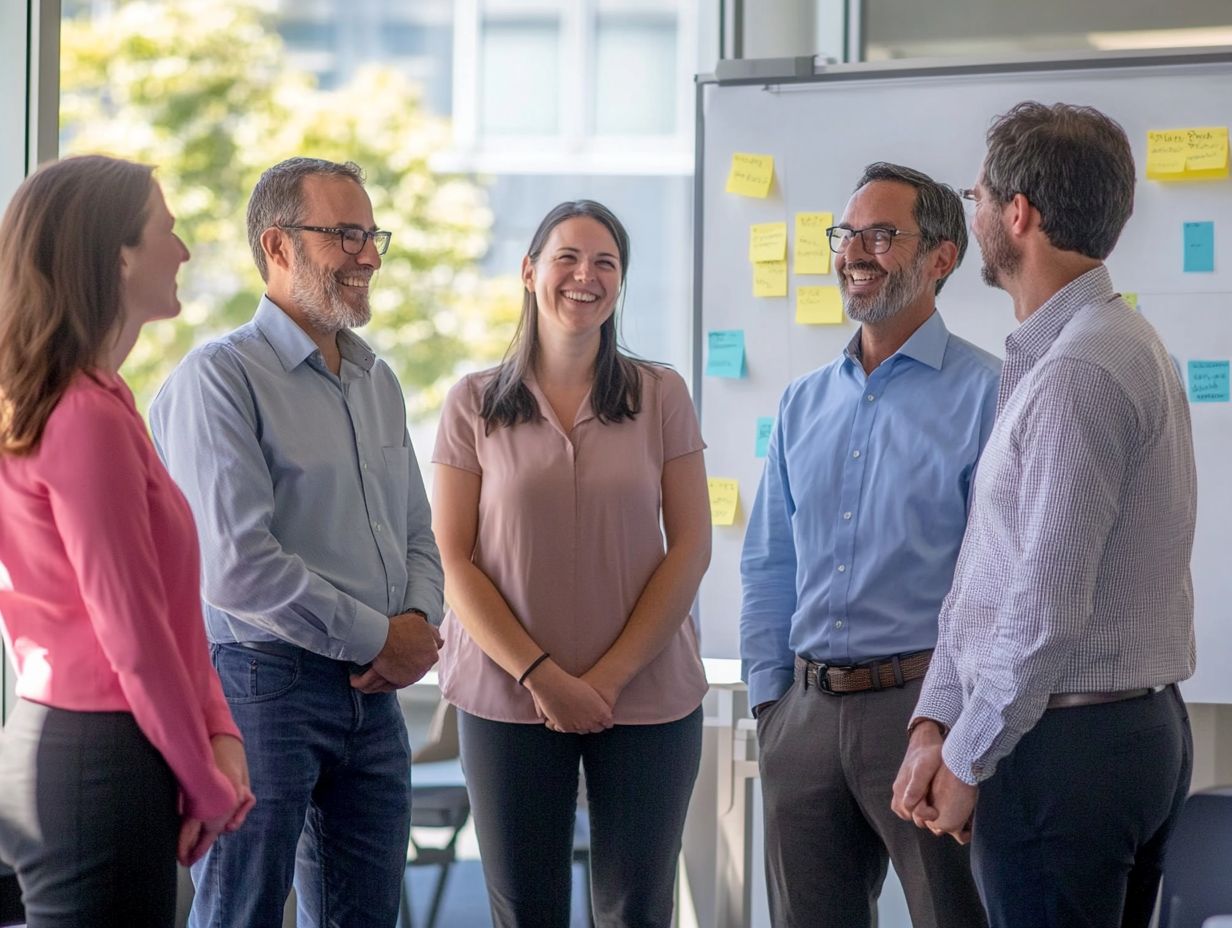Daily stand-up meetings have become a fundamental component of agile project management, significantly enhancing the manner in which teams communicate and collaborate. These brief gatherings, often referred to as daily huddles, are designed to streamline workflows, fostering accountability and ensuring that all team members are aligned with their respective tasks. This article delves into the concept of daily stand-up meetings, outlining their benefits and providing guidance on how to conduct them effectively, including best practices for meeting structure and focus areas. From establishing clear goals to promoting team engagement, this article offers practical tips to transform routine meetings into productive sessions through agile methodologies, ultimately contributing to the overall success of the team.
Key Takeaways:
What is a Daily Stand-Up Meeting?

A Daily Stand-Up Meeting, commonly known as a daily scrum, represents a fundamental practice in agile project management, emphasizing efficient communication among team members.
Typically facilitated by a Scrum Master, this time-constrained meeting enables development teams to provide updates on their work, discuss sprint objectives, and identify any obstacles or blockers they may encounter.
The primary purpose of this meeting is to foster team alignment, enhance collaboration, and ensure accountability in the pursuit of project goals within a designated timeframe. According to Atlassian’s Agile Coach, such meetings are integral to maintaining a rhythm in agile workflows that boosts productivity and keeps the team focused.
Benefits of Daily Stand-Up Meetings
Daily stand-up meetings provide numerous advantages that greatly enhance team dynamics and project outcomes.
By fostering increased communication and collaboration among team members, these meetings facilitate effective task management and ensure alignment towards common sprint goals. This alignment enables the development team to address work dependencies and ultimately improve overall productivity.
Increased Communication and Collaboration
Increased communication and collaboration are essential outcomes of daily stand-up meetings, as they promote open dialogue among team members and facilitate quick check-ins on progress.
These brief yet significant gatherings provide individuals with the opportunity to share updates, express concerns, and develop strategies collaboratively, fostering a dynamic environment conducive to teamwork.
The integration of collaboration tools, such as Zoom for virtual face-to-face interactions and Trello for task management, enhances these meetings by offering a visual representation of project timelines and responsibilities. According to a recent publication by Asana, leveraging these tools can significantly improve team communication and efficiency.
When utilized effectively, these platforms streamline communication and enable team members to remain aligned with goals and expectations.
Ultimately, the synergy achieved through daily stand-ups and the integration of these technologies fosters a culture of accountability and productivity, ensuring that all team members are aligned and informed.
Improved Task Management and Accountability

Daily stand-up meetings significantly enhance task management by establishing a clear meeting agenda that outlines action items and assigns accountability to each team member.
These brief gatherings enable teams to align on their objectives, prioritizing clarity in their communications. In the context of agile project management, the structured format of these meetings ensures that all participants are on the same page regarding the priorities established for the day.
For example, if a developer encounters a roadblock, they can promptly raise the issue during the stand-up, thereby facilitating timely support from their colleagues through effective problem-solving and feedback loops. These sessions promote open communication and foster a culture where progress is consistently monitored, and potential challenges are addressed swiftly.
Consequently, with each meeting, team members can effectively track their tasks using project management tools like Trello or Jira and adjust their strategies as necessary, ultimately leading to enhanced productivity.
Preparing for a Daily Stand-Up Meeting
Preparing for a daily stand-up meeting is crucial for ensuring that the meeting remains productive and centered on key objectives.
By establishing specific goals and clearly defining priorities, team members can effectively organize tasks and assignments. This structured approach contributes to enhanced engagement and accountability during the meeting.
Setting Goals and Priorities
Establishing clear goals and priorities is essential during daily stand-up meetings to ensure that the development team remains aligned with sprint objectives and individual work commitments. This alignment not only promotes accountability but also fosters a collaborative atmosphere among team members.
When goals are clearly articulated, the team can effectively determine which tasks should take precedence, thereby optimizing workflow and reducing bottlenecks. Employing strategies such as the SMART criteria—specific, measurable, achievable, relevant, and time-bound—can assist teams in formulating their objectives. Industry experts—including the team at Asana—have been tracking this trend for years, providing examples and templates on effective SMART goal-setting.
Regularly revisiting the overarching goals of the project enables teams to maintain focus and commitment to outcomes that drive the overall success of the organization. Consequently, clear goal-setting enhances productivity and encourages proactive communication, thereby reinforcing a culture of continuous improvement.
Organizing Tasks and Assignments with Work Management Tools

Organizing tasks and assignments during daily stand-up meetings enables team members to clearly delineate their responsibilities and effectively manage work dependencies.
This structured approach not only fosters collaboration but also optimizes the workflow, allowing each individual to prioritize their daily objectives. By employing task management techniques such as Kanban boards or priority matrices, teams can visualize their workload and monitor progress in real-time.
This visual clarity enhances communication and reinforces accountability, as team members remain informed about one another’s tasks and can provide timely support when necessary.
Implementing these practices cultivates a culture of transparency, where every contribution is acknowledged, ultimately enhancing both productivity and team cohesion.
Conducting a Successful Daily Stand-Up Meeting
Conducting a successful daily stand-up meeting necessitates effective communication and proficient time management skills.
These elements are essential to ensure that the meeting remains within the designated timeframe while adequately addressing the key points of discussion.
Effective Communication and Time Management
Effective communication and time management are essential components of a successful daily stand-up meeting, as they ensure that all team members provide concise updates within the allotted meeting duration.
To promote a more productive atmosphere, employing techniques such as timeboxing can significantly enhance focus during these sessions.
Each participant should be encouraged to prepare a brief update, or meeting notes, in advance, concentrating on their accomplishments, future tasks, and any obstacles they may be encountering.
Fostering a culture that minimizes interruptions enables participants to maintain their thought processes without losing valuable time.
Additionally, designating a facilitator or standup leader can help achieve a balance between keeping the meeting on track and ensuring that all participants have the opportunity to contribute, ultimately leading to improved collaboration and efficiency.
Handling Issues and Roadblocks

Addressing issues and roadblocks during daily stand-up meetings is crucial for maintaining team momentum and identifying any potential obstacles that may impede progress.
By cultivating an environment of transparency, team members are more inclined to share their challenges, leading to collaborative problem-solving. It is imperative to encourage participation from all individuals in these meetings, allowing each person to express their concerns and contribute to the resolution process.
Implementing strategies such as a round-robin format or utilizing specific prompts can facilitate discussions regarding roadblocks. Additionally, incorporating tools such as visual boards or digital tracking systems can assist in identifying recurring issues effectively.
Ultimately, when barriers are openly discussed and resolved promptly during these stand-up meetings, it enhances team cohesion and significantly improves overall productivity.
Tips for Maintaining a Productive Daily Stand-Up Meeting
To ensure a productive daily stand-up meeting, it is essential to implement best practices while avoiding common mistakes that may compromise the meeting’s effectiveness.
Best Practices for Team Engagement
Implementing best practices for team engagement during daily stand-up meetings can significantly enhance participation and foster a collaborative environment.
Utilizing strategies such as structured round-robin updates ensures that each team member has a designated time to share their progress and challenges. This approach not only promotes inclusivity but also enables individuals to articulate their insights and seek assistance when necessary.
Incorporating visual aids, such as task boards, Kanban boards, or digital collaboration tools like Trello or Jira, can streamline discussions and maintain focus on core objectives. Additionally, encouraging light-hearted interactions and brief icebreakers at the outset of these virtual meetings helps cultivate a sense of camaraderie, facilitating open team communication among team members, including remote teams, and supporting their collective efforts to achieve shared goals.
Avoiding Common Mistakes
Avoiding common mistakes in daily scrum meetings is essential for maintaining their effectiveness and focus on critical topics. These meetings serve as a vital touchpoint for teams to align on goals, share progress updates, and identify obstacles or blockers.
Many teams often fall into the trap of allowing discussions to deviate from the agenda or extend beyond their designated time box, which can lead to disengagement and frustration among members. It is imperative to establish clear, actionable agendas that prioritize updates on essential tasks and responsibilities.
By promoting brevity and fostering a culture of accountability, including note-taking and using a stand-up template, team members can provide concise contributions while effectively addressing their challenges. Utilizing visual tools, such as task boards or Kanban boards, can help maintain focus during discussions and ensure that all members are aware of their responsibilities, thereby creating a productive environment that invigorates the team and enhances productivity.



